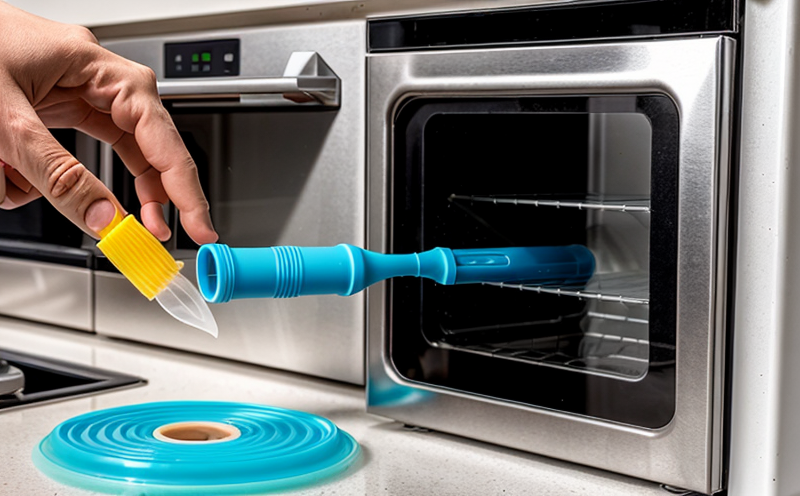ASTM D4577 Household Plastics Compression Resistance Testing
The ASTM D4577 standard specifies a method for determining the compression resistance of household plastics under specified conditions. This test is crucial in ensuring that products meet safety and performance requirements, particularly in environments where they are subjected to repeated pressure or force.
Household plastics are widely used in various consumer goods such as kitchenware, toys, furniture, and packaging materials. The durability and resistance of these plastics under compression can significantly impact product longevity and user safety. ASTM D4577 provides a standardized approach to evaluating this critical property by subjecting specimens to defined loads over specific times.
The test involves compressing the sample in a compression tester until it reaches a predetermined failure point or deformation level. This ensures that manufacturers can compare results across different products and materials, fostering consistency and reliability in product design and production.
For quality managers and compliance officers, ASTM D4577 is essential for ensuring that household plastics meet regulatory standards. It helps in identifying potential weaknesses in plastic formulations early in the development process or during quality control checks. For R&D engineers, this test provides insights into material performance under real-world conditions, guiding improvements to product design.
ASTM D4577 is one of several standards used in the broader context of polymer and plastics testing. It complements other tests like those addressing flexibility, impact resistance, and chemical resistance, contributing to a comprehensive quality assurance program for household products.
The test procedure outlined in ASTM D4577 ensures that the results are reproducible and comparable across different laboratories. This standardization is vital for maintaining consistency in product performance and safety across various manufacturers and regions.
Understanding the nuances of ASTM D4577 can help stakeholders make informed decisions about material selection, process optimization, and product development. By adhering to this standard, companies not only meet regulatory requirements but also enhance their reputation for producing high-quality products.
Applied Standards
| Standard | Description |
|---|---|
| ASTM D4577-18 | This standard specifies the procedure for determining compression resistance of household plastics under specified conditions. |
| ISO 6603:2009 | An international standard that covers similar aspects but is applicable to a broader range of plastic materials. |
| EN ISO 178-5 | A European standard providing additional guidelines for determining tensile and compression properties. |
These standards ensure that the testing methods are consistent across different regions, laboratories, and industries. By adhering to these norms, manufacturers can ensure that their products meet both local and international quality and safety standards.
Benefits
The benefits of ASTM D4577 Household Plastics Compression Resistance Testing are numerous and impactful for various stakeholders:
Enhanced Product Safety: By ensuring that household plastics can withstand compression forces without deforming or failing, this test enhances the safety of products used in homes.
Improved Durability: Products that pass ASTM D4577 are likely to have a longer lifespan, reducing waste and environmental impact.
Regulatory Compliance: Meeting these standards helps manufacturers avoid legal issues and penalties associated with non-compliance.
Market Differentiation: Products that meet or exceed the requirements of this standard can be marketed as high-quality and reliable, potentially attracting more customers.
Cost Efficiency: Early identification of material weaknesses through testing leads to fewer rejections during production and improved overall efficiency.
Innovation Support: By providing insights into material performance under stress, ASTM D4577 supports R&D efforts aimed at developing new and improved household plastics.
Overall, adherence to ASTM D4577 ensures that manufacturers produce products that are safe, durable, compliant with regulations, and competitive in the market.
Environmental and Sustainability Contributions
Reduction of Waste: Products that pass this test are less likely to break or deform, reducing waste generation during use.
Recyclability Enhancement: Durable products made with materials that meet ASTM D4577 requirements can be more easily recycled at the end of their life cycle.
Energy Efficiency: Longer-lasting products contribute to energy efficiency by requiring fewer replacements, thus reducing overall resource consumption.
Resource Conservation: By promoting the use of durable materials, this test indirectly supports efforts to conserve natural resources.
These environmental and sustainability contributions align with broader industry initiatives aimed at creating a more sustainable future. ASTM D4577 plays an important role in these efforts by providing a standardized method for assessing material performance that is consistent with global sustainability goals.





